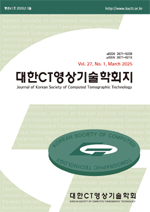규격화된 요오드화 조영제 투여량 적용에 따른 유해반응 사례 비교
Comparison of Adverse Drug Reaction According to the Application of Standard Injection Volume
- 대한CT영상기술학회
- 대한CT영상기술학회지
- 제27권 제1호
-
2025.0399 - 107 (9 pages)
-
DOI : 10.31320/JKSCT.2025.27.1.99
- 62

본 연구에서는 요오드화 조영제 CT 검사를 받은 77,581명의 환자를 대상으로 후향적 조사를 시행하였다. 성별, 연령대, 조영제 유해반응, 조영제 성분을 분석하였으며 대상기간 동안 발생한 조영제 유해반응에서는 성별에서 남성보다 여성에서 발생률이 높았으며 연령대는 60세 이상보다 60세 미만에서 발생률이 높았다. 과민반응과 생리적 반응 나누어 살펴보면 과민반응은 여성에서 발생률이 높았으며 연령대는 60세 미만에서 발생률이 높았다. 생리적 반응은 성별 간의 유의한 차이는 없었으나, 60세 미만에 서 발생률이 높았다. 조영제 성분별 과민반응 발생률은 Iopromide가 높은 발생률을 보였고 생리적 반응 발생률은 Iomeprol이 높은 발생률을 보였다. 규격화된 요오드화 조영제 투여량 적용 전 후 조영제 유해반응 발생 사례를 비교해보면 과민반응 발생률은 통계적으로 유의하지 않았으나 생리적 반응 발생률은 감소하였으며 통계적으로 유의한 결과를 보였다. 규격화된 조영제 투여량을 적용하여 조영제 양을 감소시키면 생리적 반응 예방에 도움이 될 것으로 사료된다.
In this study, a retrospective survey was conducted on 77,581 patients who underwent CT scans of an iodinated contrast media. Gender, age group, adverse drug reaction, and contrast components were analyzed, and in the adverse drug reaction occurring during the survey period, the incidence rate was higher in women than in men in gender, and the incidence rate was higher in women under the age of 60 than in men. Dividing hypersensitivity reaction and physiologic reaction, the incidence rate of hypersensitivity reaction was high in women, and the incidence rate was high in those under the age of 60, and physiologic reaction were not significantly different between genders, but the incidence rate was high in those under the age of 60. Iopromide showed a high incidence of hypersensitivity reaction by contrast Media, and Iomeprol showed a high incidence rate of physiologic reaction. Comparing the cases of adverse drug reaction before and after the application of a standardized iodized contrast media dose, the incidence of hypersensitivity reaction was not statistically significant, but the incidence of physiologic reaction decreased and statistically significant results were obtained. It is thought that reducing the amount of contrast media by applying a standardized contrast media dose may help prevent physiologic reaction.
Ⅰ. INTRODUCTION
Ⅱ. MATERIAL AND METHODS
Ⅲ. RESULT
Ⅳ. DISCUSSION
Ⅴ. CONCLUSION
REFERENCES
(0)
(0)